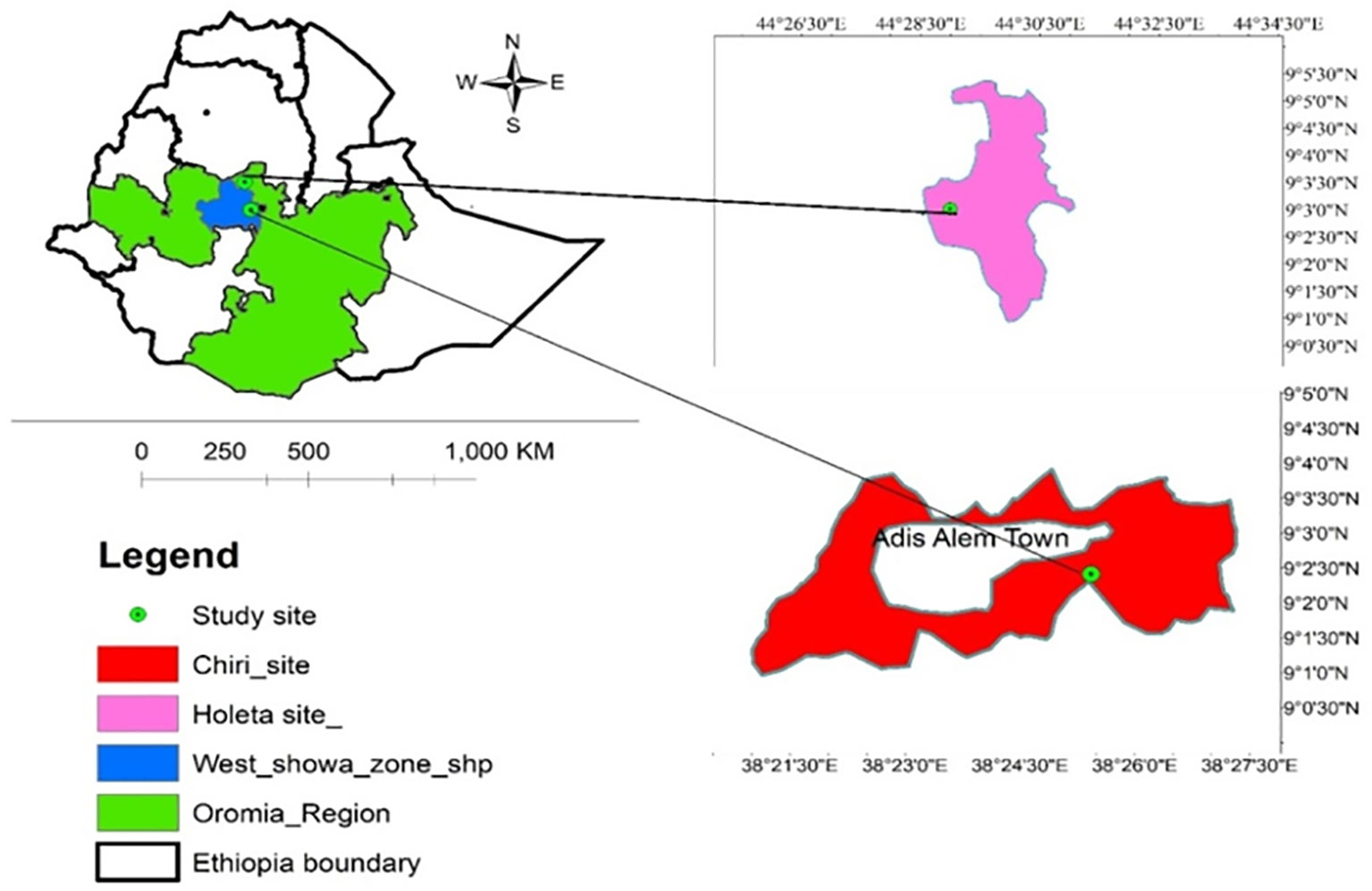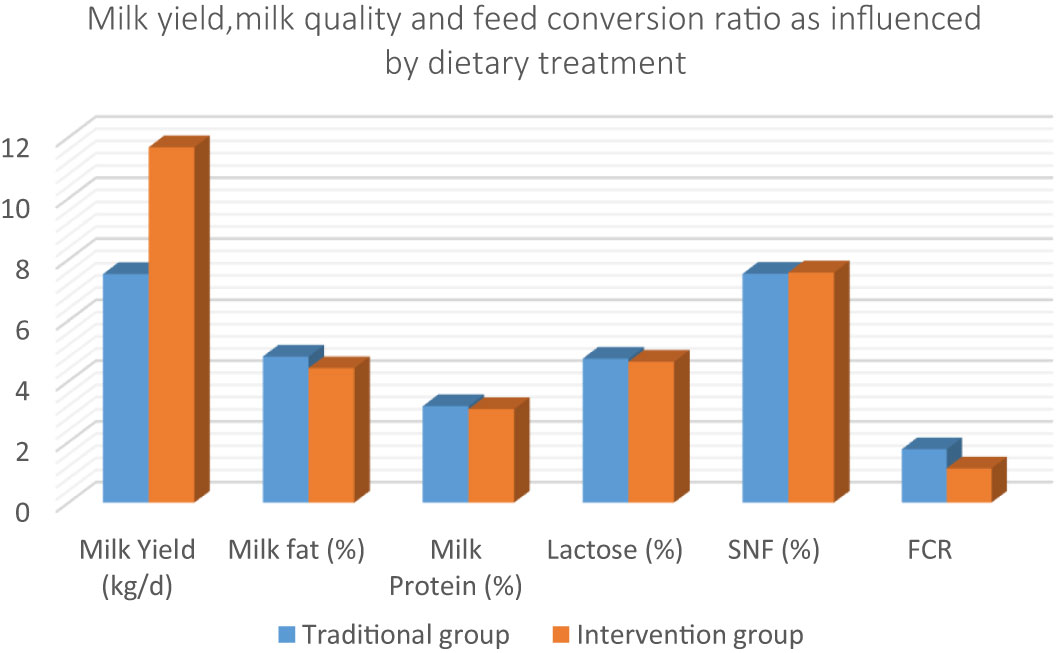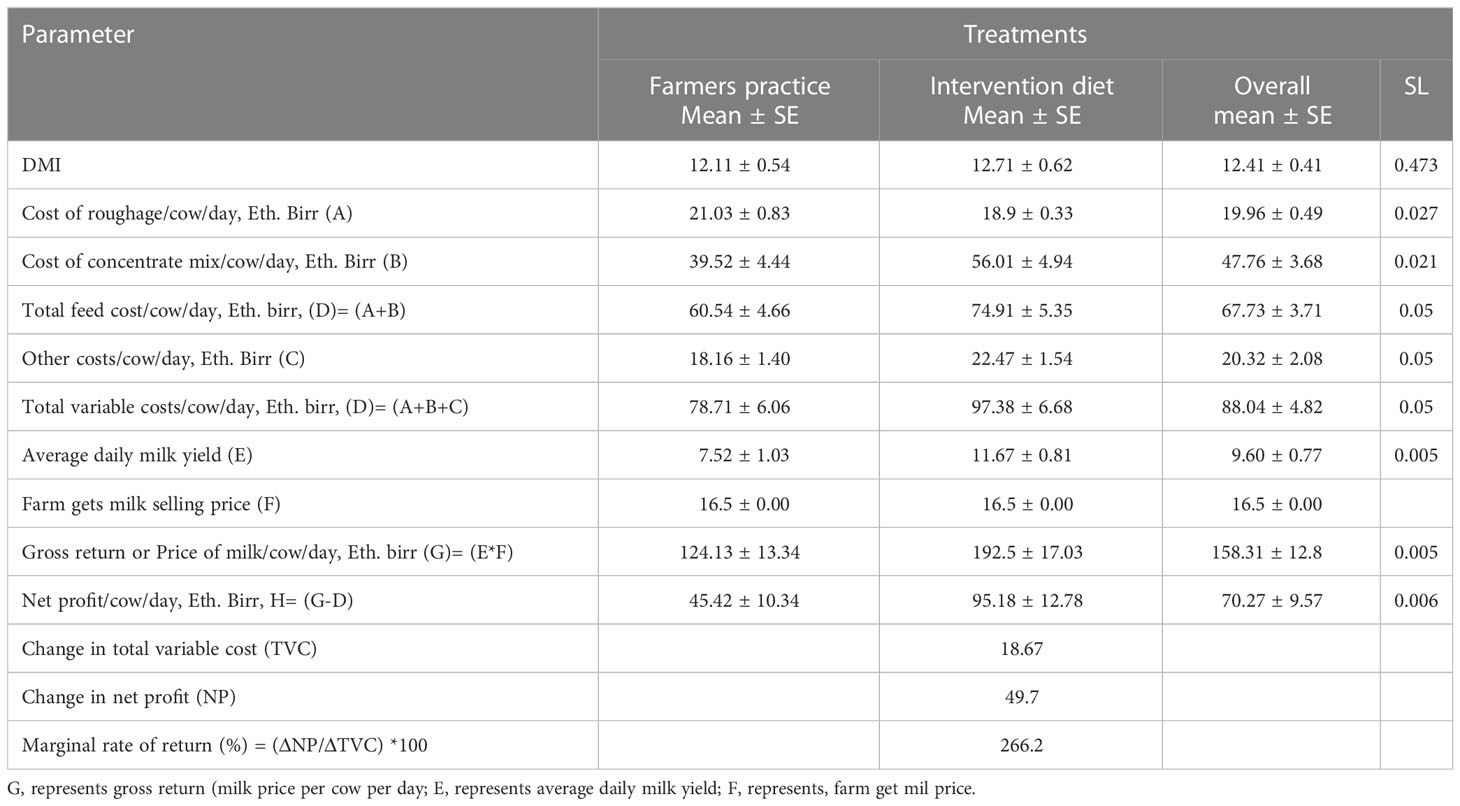- 1Feeds and Nutrition Research Program, Hletta Agricultural Research Center, Holetta, Ethiopia
- 2Ethiopian Institute of Agricultural Research, Livestock Research Process, Addis Ababa, Ethiopia
- 3Feed the Future Innovation Lab for Livestock Systems, University of Florida, Gainesville, FL, United States
- 4Department of Animal, Rangeland and Wildlife Sciences, Mekelle University, Mekelle, Ethiopia
- 5Department of Animal Sciences and Food Systems Institute, University of Florida, Institute of Food and Agricultural Science (IFAS), Gainesville, FL, United States
Dairy cattle production is an integral part of smallholder farming systems in the central highlands of Ethiopia, but it is characterized by low milk productivity mainly due to nutritional constraints. This study assessed the comparative advantage of using improved forage-based feeding system over the traditional feeding practices on feed intake, milk yield and quality, and cost benefit analysis of crossbred dairy cows under smallholder farmers. The study was conducted at Welmera and Ejere districts on 12 farmers and two cows per farmer, and two dietary treatments were assigned to each cow randomly, and the study lasted 8 weeks. The treatments were: 1) intervention diet composed of oats-vetch mixture hay with concentrate supplementation at the rate of 0.5 kg/l of milk and 2) basal diet following farmers’ current feeding practices: crop residues and native hay, commonly soaked with local brewery residue (“Atela”) and water. The results showed that there was no difference in total dry matter intake between the two diets. However, the basal feed intake was higher in the traditional feeding practice by 11% whereas the concentrate intake was higher in the intervention diet by 25%. Crude protein intake was significantly higher (P<0.05) in the intervention group by 23%. As a result, milk yield was increased by 36% under oat-vetch mixed fodder-based feeding system as compared to the traditional feeding practice. Consequently, the amount of feed required per unit of milk was lower in the intervention group, indicating higher feed conversion efficiency as compared to the traditional feeding practice. On the other hand, there was no significant variation in milk composition between the two groups. Partial budget analysis indicated that the benefit from the intervention diet (95 birr/cow/day) was greater by 266% than that obtained from the traditional practice (45 birr/cow/day). Utilization of improved forage varieties was proven to play significant role in supplying good quality and abundant feed resource that increased milk yield and also fetch additional economic return for smallholder farmers compared to the existing traditional practice. In general, this study demonstrates that adoption of improved forage production and feeding practices along with sufficient training on balanced ration formulation has been observed to increase dairy productivity and food security through provision of sustainable livelihood opportunity for smallholder farmers.
Introduction
Cattle production is an integral part of mixed crop livestock farming system in the central highlands of Ethiopia. The country has the largest livestock population in Africa (CSA, 2020)) and dairy has been identified as one of the priority commodities given attention by the government, with the aim to increase milk production. Given the potential, dairying is expected to significantly contribute to the national economy as well as to family food security, income and livelihoods. Among the various interventions required for improving smallholder dairy productivity, improving supply of adequate quantity of quality feed is placed at the top as feed cost accounts for more than 70% of all dairy production costs (Manaye et al., 2009; Yami et al., 2013; Seyoum et al., 2018). In view of this, utilization of technologies that can increase milk yield and lower production cost would be preferable. Evidence shows that it is possible to lower the cost of milk production by 4.4% without decreasing the output (Odero-Waitituh, 2017).
In the Ethiopian highlands, the traditional feeding system for dairy cattle is mainly based on the use of crop residues and natural pasture hay/grazing supplemented with a little or no concentrate. Feed resources are not only of low quality, but also do not last for the whole year (Mengistu et al., 2017). Consequently, smallholder dairy cattle milk yield is low, particularly during the dry season when feed scarcity hits the highest level. On average, an Ethiopian dairy cow produces only 15% of the milk produced by the average dairy cow in the world (FAOSTAT, 2012). Crop residues estimated at 57-million-ton DM per year, account for 59% of the national feed resource in Ethiopia (EIAR, 2017). However, crop residues from cereals are generally characterized by low crude protein content and low digestibility due to high cell wall constituents (Seyoum, 2007). According to FAO (2018), available feed resources in Ethiopia are still deficient by 21, 52 and 48% to meet the requirement of ruminants for dry matter, metabolizable energy and protein, respectively.
Significant successes have been registered in identifying various adaptable and high yielding fodder species belonging to grasses, herbaceous legumes and browse trees for the various agro-ecological zones of Ethiopia. Research results indicated that improved fodder species generally have higher herbage yield potential than natural pasture. The overall average productivity of the improved fodder crops per unit area has been found to exceed the productivities of seasonally rested and continuously grazed natural pastures by about 3 and 10-fold, respectively (Feyissa et al., 2015). In addition to their productivity, most of the improved forage crops are also nutritionally superior to that of natural pasture and crop residues. In a feeding trial that involved various levels of vetch (Vicia dasycarpa) hay supplementation in a Napier grass (Penissetium purpureum) based diet in lactating cows, provision of vetch hay at the rate of 20% resulted in higher daily dry matter intake and milk yield (Aemiro et al., 2010). Improved forage crops also have a long growing season and help to extend the green feed period so as to provide useful nutrients mainly in rural areas where availability and accessibility of agro-industrial by products are limited (Getnet et al., 2016).
Thus, the integration of improved forages into the existing dairy farming systems is a viable option to remedy the challenge in basal feed resource availability and unpredictable and rising prices often observed under various dairy production systems in Ethiopia. Forage species such as vetch (Vacia sativa) and oats (Avena sativa) are high potential feed resources to fill the gap of feed shortage (Negash et al., 2017). Promising improved forage oats varieties have been released from Holetta research center suitable and recommended for the central highlands of Ethiopia (Getnet et al., 2016). Thus, this study was conducted to evaluate the comparative advantage of feeding improved forage-based feeding system on milk productivity of crossbred dairy cows compared to the traditional feeding practices under smallholder management.
Materials and methods
Description of the study areas
The on-farm feeding experiment was conducted between April and June, 2020 for 60 days to demonstrate and evaluate oats-vetch mixed fodder-based feeding system on feed intake, milk yield, milk quality and cost benefit analysis using crossbred dairy cows under farmers’ management condition. The study was conducted in two selected milk shed districts (Ejere and Wolmera), West Shewa Zone of the Oromia Regional State in the central highlands of Ethiopia (Figure 1). The two districts were typical representatives of market-oriented smallholder crop livestock production systems.
Ejere district is located 40 km west of Addis Ababa between 8°51’16”N to 9°14’53”N and 38°15’2”E to 38°28’45”E. The altitude of the area ranges from 2060 to 3185 masl with an average rainfall of 1100 mm. The minimum and maximum temperature of the district is 9 and 28°C, respectively (Ejere Agricultural Development Office, 2020). The district is characterized by a crop-livestock mixed farming system where cereal crops such as Teff, Wheat, Barley and Maize are commonly grown. Cattle, sheep and goat are the dominant ruminant species that support the livelihood of the farming community in the district. This district is one of the milks shed areas and well linked to fluid milk market. Moreover, from the various crops grown in the area, different crop residues are produced and conserved for use as feed during periods of feed shortage. The area is closer to Holetta Agricultural Research Center and easily accessible for monitoring and sampling of crop residues for laboratory assessment.
Welmera district is located 30 km West of Addis Ababa along the main road to Ambo. Geographically, the area is situated at 8°50’ - 9°15’N and 38°25’ - 38°45’E with an altitude ranging from 2060 to 3380 masl. The district has a bimodal rainfall patterns. The minimum and maximum annual temperature is 0.1 and 27°C, respectively. Crop-livestock mixed farming is a typical agricultural practice in the area. Livestock production consists of cattle, sheep, goats, equines and poultry. Dairy production is a common practice in the district and because of its proximity to Addis Ababa with better market access, fresh milk sale is the major source of income for producers.
Oats-vetch mixed forage production
As part of the adoption and demonstration of forage technologies under the fodder component of the EQUIP project, improved forage materials were distributed and evaluated for their agronomic performance, yield and quality parameters under the farms of more than 140 dairy farmers in different locations around the Addis Ababa milk shed. Among the different improved forage materials demonstrated, further study was conducted to evaluate the feeding value of oats and vetch mixture at a ratio of 3:1 by seed weight. Twelve volunteer dairy farmers who were willing to allocate an average of 0.25 ha land for oats-vetch production, who own two crossbred dairy (Boran-Frisian cross) cows and who were willing to keep record and provide data were selected among the participants. The oats-vetch mixture was planted during the main rainy season (last week of June 2019) and fertilizer (diammonium phosphate) was applied at the rate of 100 kg/ha at the time of planting. The oats-vetch mixture was harvested 3 months after planting when the oat was at soft dough stage and when the vetch attained about 50% flowering stage. Before the total harvest, representative samples were collected using a 1m-by-1m quadrat, from three random areas per plot for yield and quality estimation. Oats-vetch mixed forage was then harvested, properly dried as hay and stored under shade until the feeding trial commenced.
Dietary treatments and experimental designs
Twelve farmers who own at least two lactating cows and who own sufficient amount of feed resources were considered for this study. From each of the 12 farmers, two lactating cows were selected, one of which was subjected to the traditional feeding practice and the other one to the oats-vetch based intervention diet. The intervention diet, T1, based on oats-vetch mixture as a basal diet supplemented with a concentrate mixture. The control group, T2, (farmer’s practice which consisted of native pasture hay, crop residue and locally available supplemental feed resources). The cows were fed and watered individually. For the intervention diet, the basal feed was offered ad libitum and the concentrate mixture was offered at the rate of 0.5 kg per liter of milk produced. A concentrate mixture was prepared from wheat bran, noug (Gizotia abyssinica) seed cake and salt at a ratio of 60:39:1, respectively. The cows were exposed to the diet for an adaptation period of 14 days, followed by 60 days of actual data collection. Samples of offered feed ingredients were collected to determine chemical composition and nutritive value. Milking was conducted by hand twice per day at 6:00 am in the morning and at 6:00 pm in the evening. The data on feed intake, milk yield, milk quality, variable cost and milk sale price were collected and subjected to analysis using the independent t-test.
Stakeholder training and feed preparation
Both theoretical and practical training was provided to participant farmers (two members per household), development agents (three per district) and district experts (one per district) on improved forage production, management, ration formulation and utilization at Holetta Research Center. Concentrate mixture was provided to participants in the intervention group that is sufficient to supplement one lactating cow for the experimental period. Before feeding, the oats-vetch mixture was properly chopped, weighed and stored in clean sacks.
Laboratory analysis
The chemical composition and digestibility of the feed samples were analyzed at the national animal nutrition laboratory of Holetta Agricultural Research Center and International Livestock Research Institute. Dried samples were ground to pass through a 1mm sieve. Near Infrared Spectroscopy (NIRS) was used to analyze the samples. The NIRS machine used equations calibrated and validated by the conventional wet chemistry analysis (AOAC, 1990). The NIRS instrument used was a FOSS Forage Analyzer 5000 with software package WinISI II. Predicted nutritional variables were nitrogen (N) (Crude protein = N*6.25), neutral detergent fibre (NDF), acid detergent fibre (ADF), acid detergent lignin (ADL), dry matter (DM), total ash and in vitro organic matter digestibility (IVOMD). Metabolizable energy (ME) was estimated from digestible energy (DE) which in turn was estimated from the IVOMD (NRC, 2001): DE = (0.01*(OM/100) *(IVOMD+12.9) *4.4) - 0.3; ME (MCal/kg) = 0.82*DE.
Milk samples were collected in a clean plastic cup at both morning and evening milking times during the last seven days of the experimental period and immediately placed inside an icebox and taken to laboratory for milk composition analysis. The milk samples were analyzed for fat, protein, total solids, and lactose contents. NIR-Infrared milk product analyzer (user manual ver. 1.1, 2000) was used for analyzing milk composition.
Partial budget analysis
The partial budget analysis was performed to evaluate the economic advantage of the intervention diet over the traditional feeding practices. The analysis involved the calculation of the variable costs of experimental feeds and other inputs and milk sale. The feed cost for both treatments were computed by multiplying the average daily feed intake per cow with the current feed price at the local market. The total variable cost of improved forage, native pasture, crop residue and concentrate feeds was estimated using the local market price. Other input costs were calculated as 30% of the feed cost because 70% of the total cost of production for dairy production is assumed to be feed cost. The average daily revenue was calculated based on the amount of average milk yield/cow/day multiplied by farm gate milk selling price. Based on the price given by each dealer, the average selling price for each treatment was calculated. In the analysis, the average daily return (TR) was determined by calculating the difference between the average daily milk sale per cow per day and the average cost of variables per cow per day. The partial budget analysis measures profit or losses which were the net benefits or differences between gains and losses for the proposed change and includes calculating net return (NR), i.e., the amount of money left when total variable costs (TVC) are subtracted from the total returns (TR).
Total variable costs include the costs of all inputs that change due to the change in production technology. The change in net return (ΔNR) was calculated as the difference between the change in total return (ΔTR) and the change in total variable cost (ΔTVC), and this is to be used as a reference criterion for decisions on the adoption of new technology.
The marginal rate of return (MRR) measures the increase in net income (ΔNI) associated with each additional unit of expenditure (ΔTVC). This is expressed in percentages as:
Statistical analysis
The data was subjected to independent T-test analysis using the Stata procedure (StataCorp, 2017) to compare feed and nutrient intake, milk yield, milk quality and cost benefit analysis between intervention and control groups. The following statistical model was used for the analysis. Yij = μ + Xi + Eij. Where, Yij = is the response variable, μ = over all mean, Xi = the treatment effect and Eij = random error.
Result
Feed types and proportion of the diet
The feed type and proportion of ingredients in the intervention and traditional diet are indicated in Table 1. For the intervention group, the feed type grown were oats-vetch mixed forage in the proportion of three to one respectively. In this group, the basal diet and the concentrate mixture consisted of 56 and 44% of the diet respectively. While in the traditional feeding system, the ration was formulated from basal diet and concentrate mixture at the rate of 62% and 38% respectively. Within the traditional system, the basal diet used were crop residue (55%) and natural pasture hay (45%). When the two groups are compared, the proportion of the basal diet was higher in the traditional group while the proportion of concentrate mixture was higher in the intervention group (Table 1).
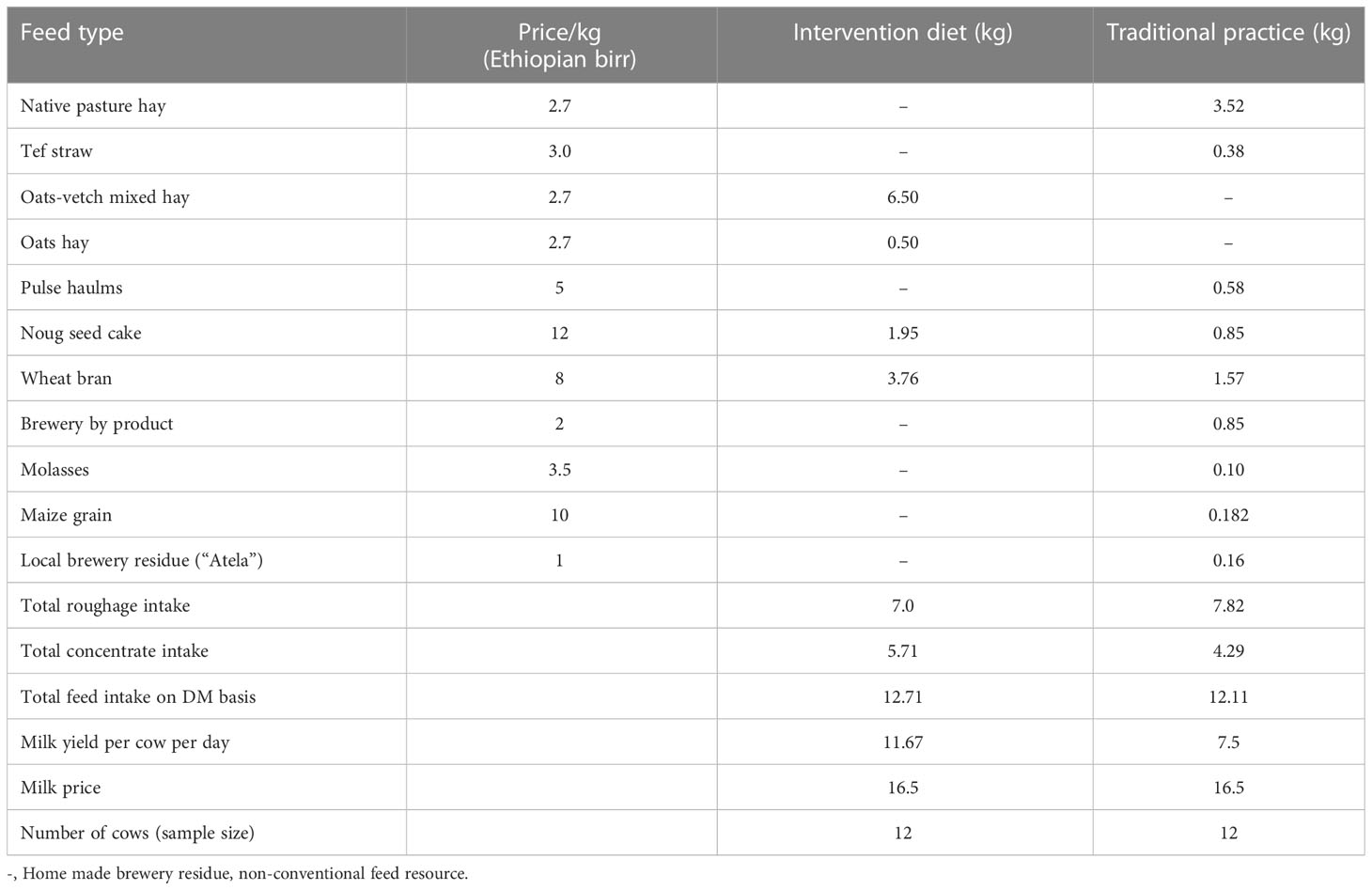
Table 1 Feed types and proportion of the diet used in the intervention and traditional feeding practices.
Chemical composition, dry matter and nutrient intake of feed ingredients and dietary treatments
The chemical composition and in vitro dry matter digestibility of feed ingredients and dietary treatments are indicated in Table 2. Based on the laboratory evaluation, the CP content and IVDMD were observed to be higher for the intervention diet by 30% and 16% respectively. On the other hand, the NDF and ADF content was lower for the intervention diet by 13% and 14% respectively. Dry matter and nutrient intake of the intervention and traditional group are indicated in Table 3. There was no variation in total dry matter intake between the two feeding systems. However significant difference (P<0.05) was observed in basal diet and concentrate intake between the two groups.
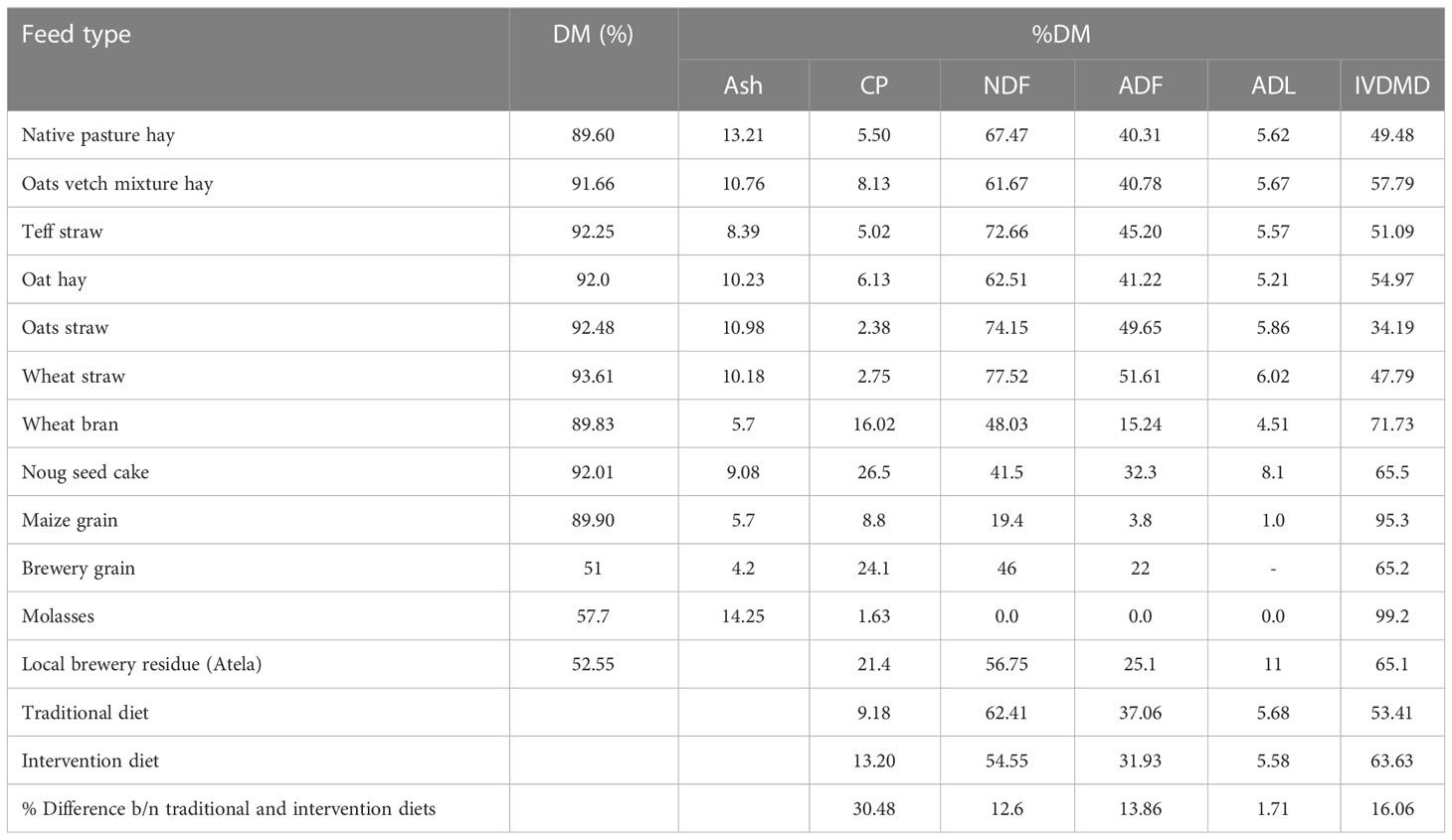
Table 2 Chemical composition and in-vitro dry matter digestibility of feed ingredients and dietary treatments used in the feeding trial.
Milk yield, milk quality and feed conversion ratio
Milk yield, milk quality and feed conversion ratio data of the intervention and traditional groups are indicated in Figure 2. The use of oats-vetch mixed fodder adlibtum and supplementation with 0.5 kg of concentrate mixture per liter of milk, increased daily milk yield by 4 liters per cow per day compared to the traditional practice.
The average milk yield in the intervention group increased from 8.5 to 11.6 liters per cow per day for the first three weeks and then remained stable afterwards while there was no change observed (7.5 liter per cow per day) in the traditional feeding practice (Figure 3). Similarly, the dry matter intake increased with increasing level of milk and remained constant after the third week, which indicates that the milk yield potential of the cow does not go beyond that level and feeding higher than that is not economical (Figure 4). In the intervention group, feed conversion efficiency decreased for the first three weeks and become stable for the following 5 weeks (Figure 5). While in the traditional diet it remained constant but higher than the conventional diet. This implies that the amount of feed required per liter of milk was higher for the traditional feeding practice.
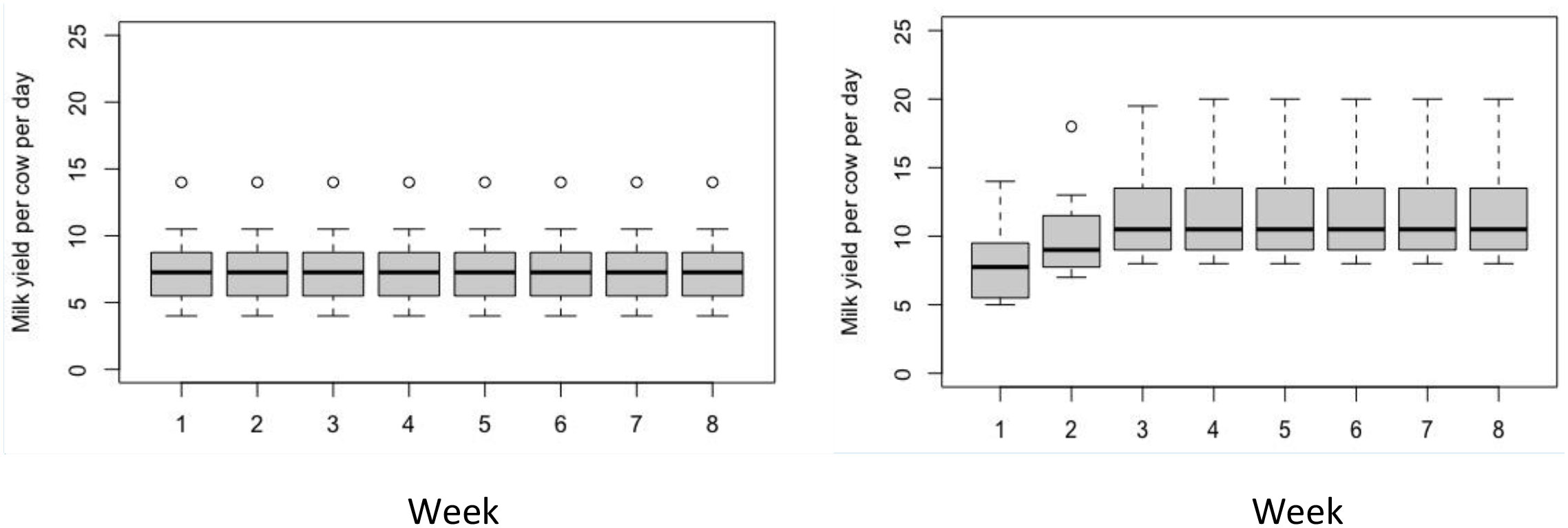
Figure 3 Comparison of effects of traditional feeding practice (left) and intervention diets (right) on milk yield (liter/cow/day).
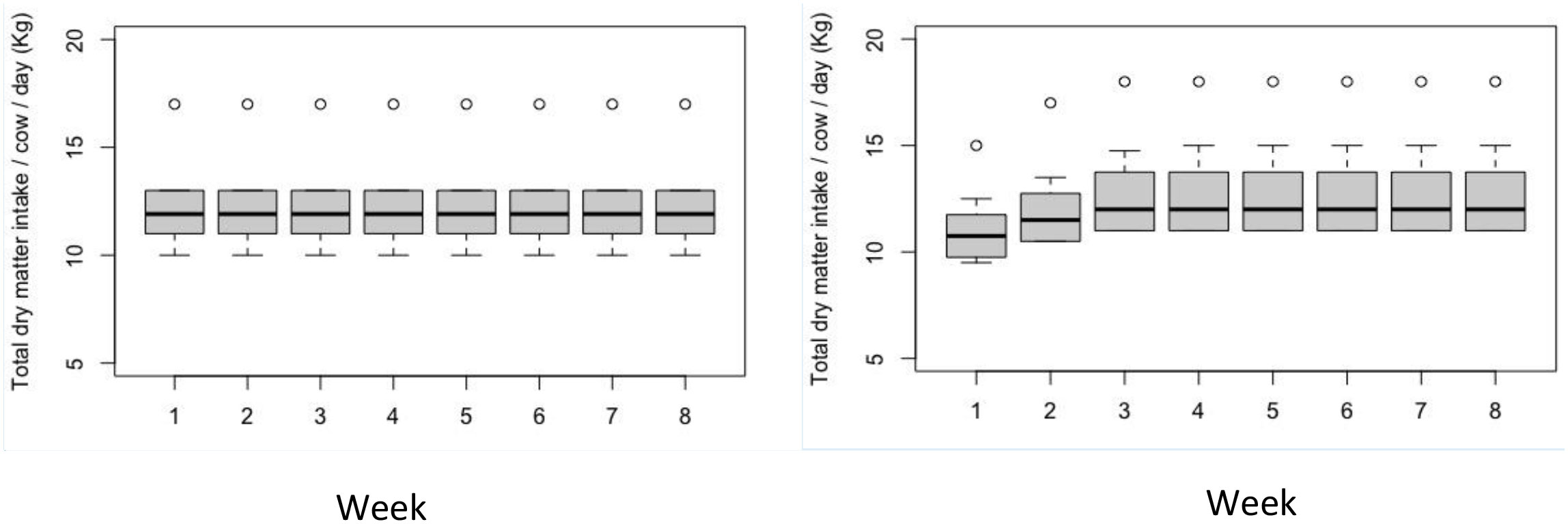
Figure 4 Comparison of effects of traditional feeding practice (left) and intervention diets (right) on dry matter intake (kg/cow/day).
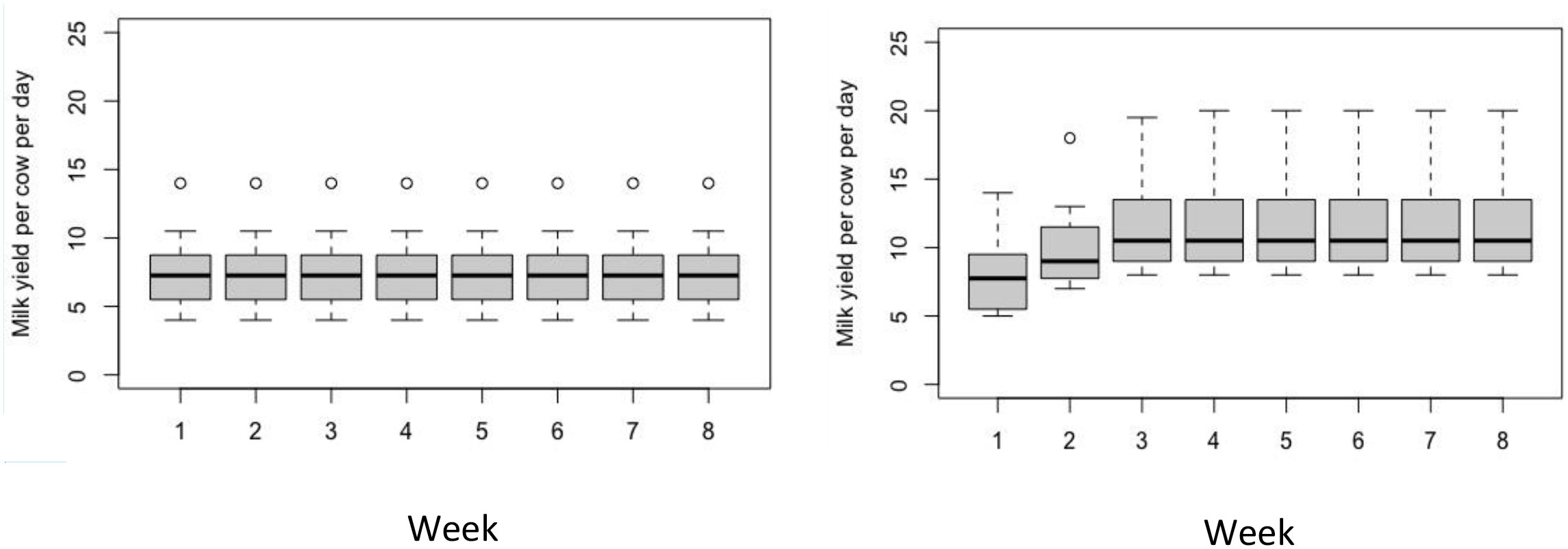
Figure 5 Comparison of effects of traditional feeding practice (left) and intervention diets (right) on milk income (Birr/day).
Economic feasibility of the intervention diet over the traditional feeding practices
Total variable cost, gross return, net benefit and marginal rate of return are indicated in Table 4. Based on the partial budget analysis, the highest net benefit was obtained from the use of intervention diet (ETB 95/cow/day) compared to the traditional group (ETB 45/cow/day). It was observed that the intervention diet had the highest variable cost, however the net benefit obtained was much higher than the variable cost. As indicated in Figure 6, income increased in the intervention group for the first three weeks and remained stable for the following weeks whereas in the traditional practice there was no change observed throughout the study period. This shows that the income in the intervention group remained higher compared to the traditional group. This confirms that the adoption and further scaling of such promising improved forage technologies bring change in milk productivity and economic benefit to small scale farmers.
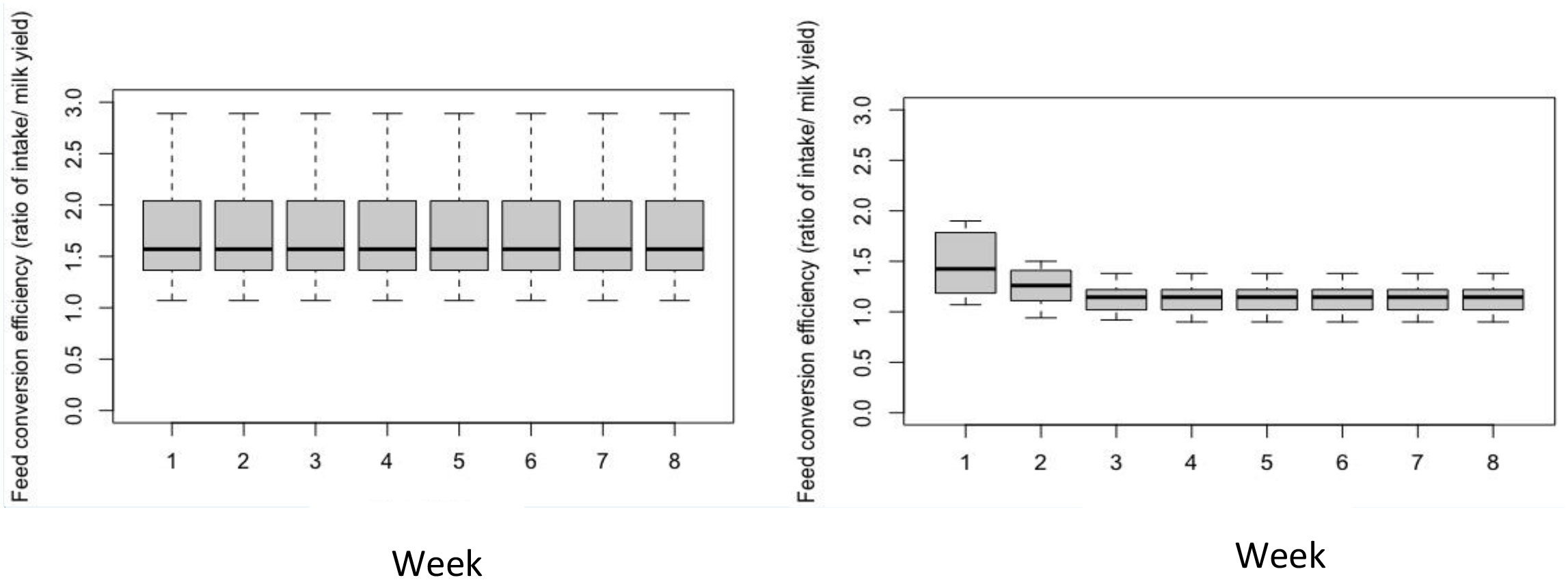
Figure 6 Comparison of effects of traditional feeding practice (left) and intervention diets (right) on feed conversion efficiency (ratio of intake/milk yield).
Discussion
Traditional feed management and feeding practice
Soaking of crop residue with local brewery and water is commonly practiced in the traditional feeding system and such practices observed to improve intake. In the traditional feeding practice, feed provision was not based on the performance of the dairy cow and most farmers provided adlibtum amount of crop residue supplemented mostly with energy sources (molasses, wheat bran, pulse haulms or maize grain). On the other hand, some farmers used native pasture hay or crop residue as a basal diet and brewery by product as a supplement. This shows that the ration was not properly formulated in terms of protein and energy balance because of poor awareness on balanced ration formulation and higher cost of commercial supplements. It was also observed that ration formulated varied among smallholder farmers because of differences in available feed resources in each household and locality. Farmers usually purchase concentrate feeds that are cheaper and available in their localities without due consideration on quality parameters.
Oats-vetch fodder production
The dry matter and crude protein yield of oats-vetch mixed fodder was in the range of 6.2 to 6.7 t/ha and 0.5 to 0.54 t/ha respectively. This was in line with the report by (Shimelis et al., 2021) who indicated that dry matter (DM) yields of the oats-vetch mixed fodder ranged from 6.4 to 7.1 t/ha. Mixtures containing 25-50% legume produce more quality and quantity forage per unit area than those of pure sowings (Alemu et al., 2007). This report was in agreement with our study where we considered 25% of the basal diet from vetch. The current study revealed that the quality of oats-vetch mixed fodder is higher than pure oats hay, native pasture hay or crop residues. This is in agreement with previous report by (Negash et al., 2017) who stated that mixed cropping of cereals with forage legumes improved both quality and quantity of fodder over a pure cereal crop.
Smallholder farmers who participated in oats-vetch mixed fodder production and utilization indicated that they are well aware of the quality and higher dry matter yield compared to the existing traditional forage production practices. In support of our findings, previous study demonstrated that the use of grass legume mixture provides attractive opportunities for sustainable animal production as they contribute to increases in forage yield, substitute inorganic nitrogen inputs for the symbiotic fixation and also increase the nutritive value of the forage (Luscher et al., 2014).
Dry matter and nutrient intake
The basal feed intake in the intervention and traditional group was 57 and 63% of the total dry matter intake respectively. High values of fibrous materials in the traditional feeding practice are likely to depress digestibility of crop residue and native pasture that constituted large segment of the diet. On the other hand, the concentrate intake was 48 and 37% of the total dry matter intake in the intervention and traditional group respectively. This shows that the basal diet intake was significantly higher in the traditional group whereas the concentrate intake was higher in the intervention group.
Crude protein intake for the intervention group was 1.57 kg per cow per day that was 13% of the total dry matter intake. On the other hand, the CP intake for the traditional feeding practice was 1.21 kg per cow per day that accounts for 10% of their total dry matter intake. Fiber (NDF) intake was higher for the traditional practice (64% of the total DM intake) than the intervention group (58% of the diet). In this study even though there was similar total dry matter intake between the two feeding systems, there was variation in nutrient intake. For instance, crude protein intake was observed to be higher in the intervention group by 23% compared to the traditional practice. Higher CP intake associated with higher digestibility has contributed to higher milk yield in the intervention group (11.67 kg per cow per day) compared to the traditional feeding practice (7.52 kg per cow per day). This indicates that promotion of improved forage development and supplementation with balanced concentrate mixture has enhanced supply of good quality feed resource.
The basal diets in the traditional feeding practices (wheat, barley and oat straw) were identified to be poor in quality that has low CP (< 2.8%) and digestibility (<48%). Such kind of traditional feeding practice based on poor quality fodder has limited the production potential of the crossbred dairy cows. In agreement with our findings, previous report indicated that traditional feeding of crossbred dairy animals suffer from under feeding in terms of nutrient requirement that caused the animals to produce below their potential (Mohamed et al., 2004).
Milk yield, milk quality and feed conversion ratio
In the current study, milk yield was significantly higher by 36% in the intervention group compared to the traditional practice. This difference in milk yield between the two groups is associated to the quality of the feed and proper formulation of balanced ration. In agreement to our findings, a study conducted in Kenya indicated that feeding oats and vetch fodder increased milk yield by up to 20% over the traditional practice and to realize adoption of such promising forage technologies, awareness creation and functioning forage seed systems need to happen concurrently (Mwendia et al., 2018). Similarly, a report by (Hintsa, 2016) indicated that the use of the oats-vetch mixed fodder as a supplement to traditional feeding resulted in daily additional milk yield of 2.33 liters per cow per day for crossbreed cattle, and 1.0 liter for local cows. Another study by Marishet et al., 2019 indicated that crossbred cows fed a basal diet of oats-vetch mixture supplemented with cottonseed cake-based concentrate mixture provided 7.97 kg of milk per cow per day which was lower than the present findings. These differences in milk yield might be associated to the variation in the level, type of ingredients, feeding management of animals among smallholder farmers and also the difference in the performance of dairy cows.
On the other hand, there was no difference observed in milk fat, milk protein, solid not fat as well as lactose content between the intervention and control group. The milk fat and protein content in the intervention diet were 4.43 and 3.15% respectively, which was in agreement with the previous report by Marishet et al., 2019, who indicated that the milk fat and protein content of dairy cows fed oats-vetch fodder were 4.44% and 2.9% respectively. The variation in milk protein in the present study can be attributed to the usual inverse relationship between milk yield and the content of milk solid components. In general, the feed conversion ratio was significantly (P<0.05) lower for the intervention group implying that less dry matter intake was required to produce a unit of milk compared to the traditional group.
Economic feasibility of the intervention diet over the traditional feeding practices
Economic visibility study is the main driving factor for adoption of feed technologies by smallholder farmers (Shimelis et al., 2021). Under the current price scenario for feed and milk, the higher benefit was obtained from the intervention diet. The marginal rate of return obtained from the intervention diet implies that for 1.0 birr invested in milk production, the producers obtained 2.66 Birr, an achievement that is above the minimum acceptable rate of return (CIMMYT, 1988). This study demonstrates that the adoption of improved feeding practices with sufficient training on formulation of balanced ration can result in higher economic benefit for smallholder dairy farmers. The cost benefit analysis of using oats-vetch mixed fodder for milk production resulted in a positive response. The variation in net return between treatments occurred due to the difference between the quality of feed and total milk yield per treatment.
Most of the participant smallholder farmers described that farm gate milk price is lower and it is decided by milk collectors despite the continuous increase in feed cost. This has been discouraging farmers from sustainable involvement in dairy production. Unless and otherwise feeding management is improved, the efficiency of livestock in terms of production and productivity as well as economic benefits are critically limited. This study demonstrated that changes in dairy feeding based on improved forage have shown significant improvement on farmer’s livelihood through increased dairy productivity and economic return. In agreement with our study, Shimelis et al. (2021) reported that the use of good quality home grown forage can result in higher economic benefit for smallholder farmers.
At the end of this study, participant smallholder farmers visualized that, production of improved forage at their own farm land enabled them to obtain good quality fodder with higher dry matter yield at a cheaper price and that significantly increased milk yield performance and economic return. Thus, it was taken as a lesson learnt for further adoption and wider application of the technology.
Conclusion
Development and utilization of improved forage species such as oats and vetch mixture were proven to play significant role in alleviating feed scarcity in quantity and quality. The introduction of improved forage-based feeding practices has resulted in higher milk production with additional economic return to smallholder farmers compared to the traditional feeding practices. In order to address the present demand for milk, the engagement of a large number of smallholder dairy farmers on improved forage production and feeding is highly essential. In general, the study demonstrates that the adoption of improved feeding practices with sufficient training on balanced ration formulation has been observed to increase dairy productivity and food security through provision of sustainable livelihood opportunity for smallholder farmers. Development of suitable extension materials should be considered to ensure popularization of the results generated from the study to wider users.
Data availability statement
The raw data supporting the conclusions of this article will be made available by the authors, without undue reservation.
Ethics statement
Ethical review and approval was not required for the animal study because we used best bet feeding system on dairy cows based on their requirement for milk yield to compare with farmers traditional practice.
Author contributions
AK did the experimental design work, conducted the experiment, analyzed the data, wrote and revised the manuscript. FF wrote and revised the manuscript. MB, ER, and AA revised and re analyzed the data. MD, GKi, DG, MM, GKe, GM, MFD, and KM revised the manuscript. All authors contributed to the article and approved the submitted version.
Funding
This work was funded in whole or part by the United States Agency for International Development (USAID) Bureau for Resilience and Food Security under Agreement # AID-OAA-L-15-00003 as part of Feed the Future Innovation Lab for Livestock Systems. Additional funding was received from Bill & Melinda Gates Foundation OPP#1175487. Any opinions, findings, conclusions, or recommendations expressed here are those of the authors alone. Under the grant conditions of the Foundation, a Creative Commons Attribution 4.0 Generic License has already been assigned to the Author Accepted Manuscript version that might arise from this submission.
Conflict of interest
The authors declare that the research was conducted in the absence of any commercial or financial relationships that could be construed as a potential conflict of interest.
Publisher’s note
All claims expressed in this article are solely those of the authors and do not necessarily represent those of their affiliated organizations, or those of the publisher, the editors and the reviewers. Any product that may be evaluated in this article, or claim that may be made by its manufacturer, is not guaranteed or endorsed by the publisher.
Author disclaimer
Any opinions, findings, conclusions, or recommendations expressed in this article are solely those of the authors alone and not necessarily represent those of their affiliated organization: the publisher or the editors.
References
Aemiro K., Getnet A., Dereje F., Getu K., Mesfin D. (2010). Milk yield and quality of crossbred dairy cows fed with different levels of vetch (Vicia dasycarpa) hay and concentrate on a basal diet of fresh cut napier grass (Penissetium purpureum). Ethiop. J. Agric. Sci. 20, 161–167.
Alemu B., Melaku S., Prasad N. K. (2007). Effects of varying seed proportions and harvesting stages on biological compatibility and forage yield of oats (Avena sativa l.) and vetch (Vicia villosa r.) mixtures Vol. 19 (Bahirdar, Ethiopia: Livestock Research for Rural Development). Available at: http://www.lrrd.org/lrrd19/1/alem19012.htm.
AOAC (1990). Official methods of analysis, 15th edition (Virginia, USA: Association of Analytical Chemists. Inc, Arlington), 1298.
CIMMYT (1988). Farm agronomic to farmers’ recommendation. an economic training manual (D.F. Mexico: International Maize and Wheat improvement Center, Mexico), 51.
CSA (2020). Report on livestock and livestock characteristics, agricultural sample survey volume II Vol. 587) (Addis Ababa, Ethiopia: Central Statistical Agency of Ethiopia).
EIAR (2017). Livestock research strategies (2016-2030): Feeds and nutrition, rangelands and animals health, Ethiopian institute of agricultural research (Addis Ababa: Ethiopian Institute of Agricultural Research), 239.
Ejere Agricultural Development Office (2020). Data on annual rainfall, altitude and temperature obtained from the agricultural office of the ejere district. (Ejere district: Ejere district agricultural office).
FAO (2018). Ethiopia: Report on feed inventory and feed balance (Rome, Italy: Food and Agricultural Organization of the united nation), 160. Licence: CC BY-NC-SA 3.0 IGO.
FAO Statistics (2012). Food and Agriculture Organization of the United Nations (Rome) Available at: http://faostat.fao.org/.
Feyissa F., Assefa G., Kebede G., Mengistu. A., Geleti D. (2015). “Cultivated forage crops research and development in Ethiopia,” in Pasture and rangeland research and development in ethiopia. proceedings of a workshop organized by Ethiopian society of animal production (ESAP) and held on 03 February 2014 at EIAR. Eds. Yami A., Assefa G., Gizachew L.(Addis Ababa, Ethiopia: Ethiopian Society of Animal production, Addis Ababa, Ethiopia).
Getnet A., Solomon M., Fekede F., Seyoum B. (2016). Animal feed resources research in Ethiopia: Achievements, challenges and future directions. EIAR 50th year golden jubilee anniversary special issue, ethiop. J. Agric. Sci. (2016), 141–155.
Hintsa H. (2016). The effect of improved fodder production on livestock productivity” in endamehoni district (Ethiopia: Mekele University), 1–80. (Dessertation/Master’s Thesis).
Luscher A., Mueller Harvey I., Soussana J. F., Rees R. M., Peyraud J. L. (2014). Potential of legume-based grassland livestock systems in Europe: a review. Grass Forage Sci. 9, 206–228. doi: 10.1111/gfs.12124
Manaye T., Tolera. A., Zewdu T. (2009). Feed intake, digestibility and body weight gain of sheep fed Napier grass mixed with different levels of Sesbania sesban. Livestock Sci. 122 (1), 24–29. doi: 10.1016/j.livsci.2008.07.020
Marishet T., Mengistu U., Getnet A., Kassahun M. (2019). Effects of sources of dietary protein supplemented to oat-vetch hay mixture on milk yield and milk composition of crossbred dairy cows. Int. J. Livestock Production. Vol. 10 (2), 56–61. doi: 10.5897/IJLP2017.0439
Mengistu A., Kebede G., Feyissa F., Assefa G. (2017). Review on major feed resources in Ethiopia: conditions, challenges and opportunities. Acad. Res. J. Agric. Sci. Res. 5 (3), 176–185.
Mohamed A., Ahmed M., Simeon E., Yemesrach A. (2004). Dairy development in Ethiopia (Washington, DC USA: EPTD Discussion Paper), 123–132.
Mwendia S. W., Mwungu C. M., Nganga S. K., Njenga D., Notenbaert A. (2018). Effect of feeding oat and vetch forages on milk production and quality in smallholder dairy farms in central Kenya (Nairobi, Kenya: Tropical Animal Health and Production). doi: 10.1007/s11250-018-1529-3
Negash D., Animut G., Urgie M., Mengistu S. (2017). Chemical composition and nutritive value of oats (Avena sativa) grown in mixture with vetch (Vicia villosa) with or without phosphorus fertilization in East shoa zone, Ethiopia. J. Nutr. Food Sci. 7, 609. doi: 10.4172/2155-9600.1000609
NRC (2001). Nutrient requirements of domestic animals, no. 4. nutrient requirements of beef cattle 6th rev (Washington DC, USA: National Academy Press).
Odero-Waitituh J. A. (2017) Smallholder dairy production in kenya; a review: Livestock research for rural development. Available at: http://www.lrrd.org/lrrd29/7/atiw29139.html.
Seyoum B. (2007). “Livestock feed potential of crop residues in Ethiopia: opportunities and challenges,” in Utilization of crop residues. Eds. Bayeh M., Getachew A., Angaw T. (Addis Ababa: EIAR), 74–100.
Seyoum B., Gemechu N., Harinder M. (2018). Ethiopian Feed industry: current status, challenges and opportunities (Addis Ababa, Ethiopia: Feedipedia).
Shimelis M., Ajebu N., Adugna T., Aberra A., Kindu M., Endalkachew W. M., et al. (2021). Forage yield and replacing concentrate supplements with oat and vetch mixed forage on the performance of sheep fed desho grass (Pennisetum pedicellatum) based diets. Ethiop. J. Appl. Sci. Technol. 12 (1), 10–17.
Keywords: oats-vetch mixture, feed intake, milk yield, traditional practice, cost benefit
Citation: Ashagrie AK, Feyissa F, Kebede G, Faji M, Mohammed K, Mengistu G, Kitaw G, Dejene M, Geleti D, Minta M, Rios EF, Balehegn M and Adesogan AT (2023) Enhancing dairy productivity through best bet feeding interventions under smallholders in the central highlands of Ethiopia. Front. Anim. Sci. 4:1118437. doi: 10.3389/fanim.2023.1118437
Received: 07 December 2022; Accepted: 23 February 2023;
Published: 08 March 2023.
Edited by:
Peter Erickson, University of New Hampshire, United StatesReviewed by:
Matt Akins, University of Wisconsin-Madison, United StatesBradley Heins, University of Minnesota Twin Cities, United States
Copyright © 2023 Ashagrie, Feyissa, Kebede, Faji, Mohammed, Mengistu, Kitaw, Dejene, Geleti, Minta, Rios, Balehegn and Adesogan. This is an open-access article distributed under the terms of the Creative Commons Attribution License (CC BY). The use, distribution or reproduction in other forums is permitted, provided the original author(s) and the copyright owner(s) are credited and that the original publication in this journal is cited, in accordance with accepted academic practice. No use, distribution or reproduction is permitted which does not comply with these terms.
*Correspondence: Aemiro K. Ashagrie, YWVtaXJvYXNoYUBnbWFpbC5jb20=
 Aemiro K. Ashagrie
Aemiro K. Ashagrie Fekede Feyissa2
Fekede Feyissa2 Gezahegn Kebede
Gezahegn Kebede Mulisa Faji
Mulisa Faji Gezahegn Mengistu
Gezahegn Mengistu